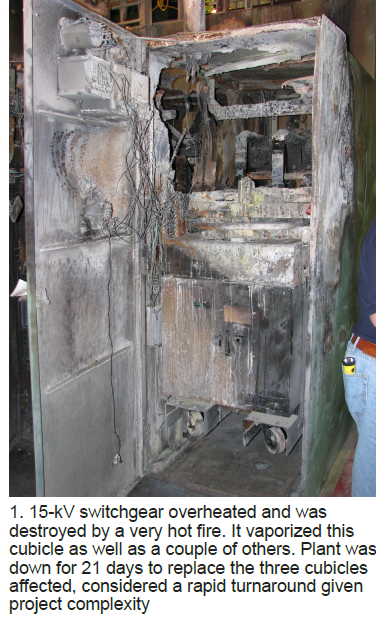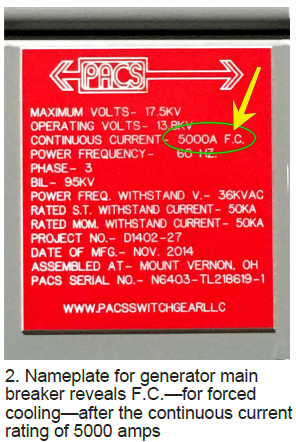At the 2016 meeting of the 7EA Users Group, Bruce Hack of National Breaker Services LLC presented on the benefits of using his company’s Citadel product line to mitigate problems with circuit breakers that several owner/operators were dealing with. After his presentation, the steering committee met with Hack to discuss ongoing issues with breakers supplied by a particular switchgear manufacturer and installed on many 7EAs. He offered to look into the group’s concerns, provided he could visit plants with breaker issues and get the details first-hand.
Through the 7EA Users Forum, Hack identified three users willing to let him visit their facilities and to discuss their challenges. At the first plant he visited, he found the breaker’s nameplate rating slightly lower than the known current output of the generator. Overheating did not seem to be an issue with the operations personnel so the matter was rested after being pointed out to the plant engineer.
Racking, alignment, and secondary contact issues also were identified. They were of major concern to the operations department because it had disabled the breaker’s use during previously needed times. The issue appeared related to insufficient/improper floor support under the breaker cubicle section. This likely would be attributable to the switchgear outdoor-house manufacturer and/or the original design team.
The remaining two plants on Hack’s list had the same 5000-amp generator main breakers—on paper. Although their nameplates said they were the same they were anything but. Hack’s survey revealed they were so different it was not possible to interchange them. Anyone trying to buy one of these as a spare for the other would be deeply disappointed at the first rack-in attempt, he said. Specifically, the cell floors varied, and the interlock positions and secondary block designs were not the same.
Heating issues had dogged both plants since COD. Additionally, some of the breaker problems that arose over the years, discussed by Hack in his 2017 presentation to the 7EA users on the results of his plant visits, included the following:
-
- Racking mechanism issues.
- Primary clusters, secondary disconnect alignment anomalies.
- Floor interlocks.
Overheating of generator main breakers was a consistent and major concern. Fire-hazard and personnel safety concerns always are paramount to any plant owner (Fig 1); plus, the potential for a plant trip and expensive forced outage can completely negate the value of a peaking unit. One plant installed thermal monitoring instrumentation as an advanced warning system, the other had multi-ton air conditioners blowing on its breakers to keep them cool.

Two questions that came to mind:
-
- Why live with the overheating problem?
- Why are the breakers overheating in the first place—is the equipment defective? The short answer is “no.”
Hack reported there was no “maintenance” money available to replace the breakers. There were requests for “capital” money, but accounting “rules” prevented using it to correct issues with problematic breakers. A wholesale upgrade and change out would have been required.
 The long answer has to do with commercial considerations. Fig 2 shows that the equipment is rated for 5000 amps (continuous), but there’s an “F.C.” that follows that information—for forced-cooled. In all probability, this was the most cost-effective offering the OEM could incorporate into the total plant package “at the time.” Whether the components and designs pushed their limits is an open and ongoing debate.
The long answer has to do with commercial considerations. Fig 2 shows that the equipment is rated for 5000 amps (continuous), but there’s an “F.C.” that follows that information—for forced-cooled. In all probability, this was the most cost-effective offering the OEM could incorporate into the total plant package “at the time.” Whether the components and designs pushed their limits is an open and ongoing debate.
Undoubtedly, Hack said, the design did not provide the sort of belt-and-suspenders safety margins that gets a plant 30 to 40 years of highly reliable, maintenance-light service. No one would have wanted an entire plant to depend on the operation of a few small fans and an auxiliary a/c system to keep breakers from overeating if it could have been avoided.
Hack dug deeper with a back-of-the-envelope calculation. He measured the lower stem of the vacuum interrupter at about 1 in. diam, meaning the conductor cross section was about 3.2 in.². A conservative rule-of-thumb suggests a maximum current flow of 1000-1200 amps/in.² for this breaker, which means it’s about 1200 amps less than the 5000-amp nameplate without forced cooling.
As Hack pointed out, “at 5000 amps you’re running a toaster in the middle of your circuit breaker. If you wick away the heat fast enough, you can keep things within limits. But the better solution is to simply use a properly rated, self-cooled 5000-amp breaker if at all possible.”
Hack’s conclusion: A better vacuum interrupter and properly paired mechanism design is needed for this breaker to be specified for 5000-amp service. As is, he believes it should not have been used above about 3600 amps, self-cooled.
A solution Hack suggested was a fixed-mounted breaker—specifically a bolted-to-the-bus Citadel breaker that has line and load air-break disconnects with an integral, interlocked grounding switch. It would eliminate the stab failure issues and provide an air-break switch with grounding for lock-out/tag-out isolation. Racking out generator breakers for maintenance activities is an issue for almost all 7EA locations.





